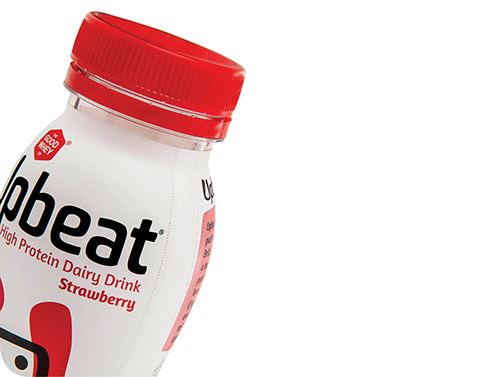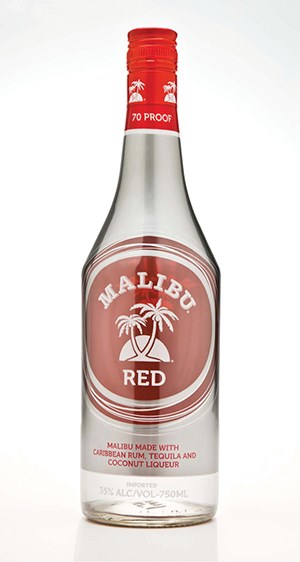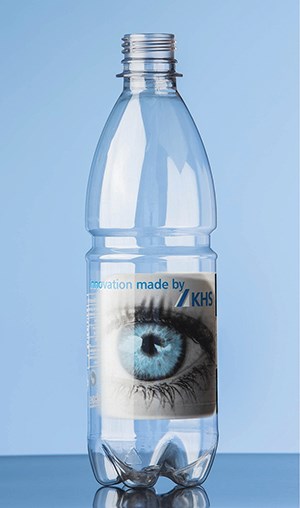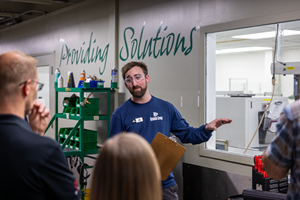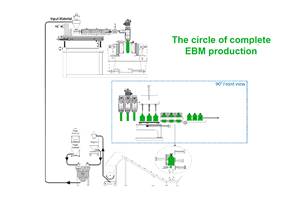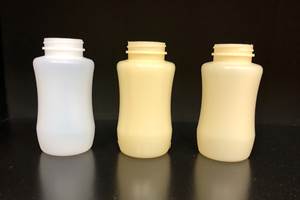Sleeve Labels Drive Packaging R&D
Packaging
Machinery and material suppliers are collaborating on new labels that don’t gum up the lucrative PET bottle reclaim business.
Full-wrap labels are as appealing to consumers as they are infuriating to recyclers. Their shelf appeal means sleeves won’t be shrinking away anytime soon, but machinery and material suppliers have heeded the downstream howls emanating from the end-of-life segment of the supply chain, and they are collaborating on new labels that don’t gum up the lucrative PET bottle reclaim business, but still give 360° of “billboard” to brand owners.
Multiple presentations at this year’s Packaging Conference (Feb. 3-5 in Orlando, Fla.) addressed full-wrap labels, including label designs and inks that promote separation from PET during recycling; labeling machines that can perforate the labels to encourage that separation; and even a direct-to-bottle printing technology that eliminates the need for labels, shrink sleeve or otherwise.
Holli Whitt, market development manager, sustainability for specialty plastics at Eastman Chemical, Kingsport, Tenn., offered an update on an industry collective created to address issues with the sleeves. The Full-Wrap Label Consortium was formed in 2012 and consists of more than 100 individuals from 50 companies up and down the supply chain, ranging from brand owners and material manufacturers to film extruders and plastics recyclers.
The key issue the consortium must address is that labels have to be removed from the bottles so recycling equipment can identify the underlying material, and then they must be segregated from the container so that the label (copolyester in the case of Eastman, which markets its Embrace material for the application) does not contaminate the PET reclaim feed. And, finally, they need to ensure no ink bleed. All of this is made trickier by the fact that the copolyester labels have a density similar to that of PET. Labels have been made from a range of materials, including PVC, PET, PE, PLA, OPS, PP, and recycled PET.
While full-wrap labels still lag behind traditional labels in market penetration, Whitt noted that they are growing quickly. Shrink-wrapped bottles jumped from around 0.65% to 3% of total bale weight in 2011, and to 5-6% in 2012, with some recyclers reporting rates as high as 7-9% in their bales.
The consortium had two meetings in 2012, looking at possible remedies such as label perforation, floatable labels, label removal at the reclaimer, ink or resin markers, thinner labels, and having consumers “unzip” the labels utilizing a twin perforation.
Eastman tested four different perforation designs against a control during a trial at Perpetual Recycling Solutions, Richmond, Va. A bale of 100% shrink-sleeved bottles was put straight into a delabeler in the first run, yielding bad results. For the next trial, they started with a wash cycle, using a Sorema de-labeler, and 97% of the perforated labels were removed. One potential problem: Whitt said that by some industry estimates, only half of the installed recycling capacity includes prewash. Still, in the consortium’s trials, even without prewashing the full-wrapped bales, they still managed to reclaim 70% of bottles.
The consortium investigated some unconventional means to address the issue as well. Working in conjunction with ink maker Sun Chemical, Parsippany, N.J., Eastman tested what Whitt called “floatable coatings.” The inks react in the recycler’s sink/float tank, foaming and sending the labels to the surface. Sun Chemical is also a looking at a coating that promotes deseaming/debonding of the labels in the bottle wash. Whitt said this idea has some potential, but more research is needed.
DIRECT BOTTLE PRINTING
What if bottles didn’t need a label at all? That was the solution put forth by Arne Wiese, product manager for bottles and shapes at filling and blow molding machinery manufacturer, KHS USA, Inc., Waukesha, Wis.. Its Innoprint technology (mentioned in our K 2013 coverage in February) allows digital inkjet printing directly on the bottle. The machine, which has a footprint of 3.7 x 9.7 m, allows full-color printing at rates up to 36,000 bottles/hr.
Weise said Innoprint uses a minimum number of print heads compared with other systems.
With bottles fixed onto a hook, Innoprint sends them through print stations that are modular and retrofittable, using 4, 8, or 12 print heads to print 12,000, 24,000, or 36,000 bottles/hr, respectively. The system can handle bottles with volumes from 0.33 to 1.5 liters and diameters from 40 to 120 mm.
Ink is UV cured with no solvents and near-instant drying to produce “brilliant colors, glossy appearance, and high durability,” according to Weise. KHS worked for more than six years to formulate the ink, weighing factors like recycling, shelf life, and adhesion. KHS promises printing with up to 1080 dpi resolution and digital-on-demand printing in lot sizes as small as one.
Weise said that various independent tests show the printed bottles are 100% recyclable in European conventional recycling processes, and direct printing has been confirmed for bottle-to-bottle recycling.
KHS continues to test the light-fastness, chemical resistance, and temperature resistance of the digital printing, as well as its stability and durability through filling and conveying. In March, KHS completed pilot installation of an Innoprint line at a customer site; and in October, KHS expects the next prototype to be ready.
SLEEVE LABELERS ON A ROLL
Machine supplier, Sidel (U.S. office in Norcross, Ga.) discussed advances in label application. The French company (sidel.com) began development of a roll-sleeve machine in 2010, according to Yann Renard, business development manager for labeler and roll-sleeve technology. Renard said that while competitive designs produce sleeves with transverse-direction orientation (TDO) in a four-step process that requires solvent, Sidel’s Rollsleeve rotary labeler offers machine-direction orientation (MDO) of sleeves in a two-step process that utilizes ultrasonic welding instead.
Output can range from 27,000 to 54,000 bottles/hr for containers up to 1.5L, diameters to 200 mm, and up to 80-mm neck size. At present, the system handles round containers only, but Sidel is working with a customer on an oval-shaped package. Renard said there are 10 Rollsleeve machines installed and running in the U.S.
Related Content
Medical Molder, Moldmaker Embraces Continuous Improvement
True to the adjective in its name, Dynamic Group has been characterized by constant change, activity and progress over its nearly five decades as a medical molder and moldmaker.
Read MoreGet Color Changes Right In Extrusion Blow Molding
Follow these best practices to minimize loss of time, material and labor during color changes in molding containers from bottles to jerrycans. The authors explore what this means for each step of the process, from raw-material infeed to handling and reprocessing tails and trim.
Read MoreWhat to Look for in High-Speed Automation for Pipette Production
Automation is a must-have for molders of pipettes. Make sure your supplier provides assurances of throughput and output, manpower utilization, floor space consumption and payback period.
Read MoreHow to Extrusion Blow Mold PHA/PLA Blends
You need to pay attention to the inherent characteristics of biopolymers PHA/PLA materials when setting process parameters to realize better and more consistent outcomes.
Read MoreRead Next
See Recyclers Close the Loop on Trade Show Production Scrap at NPE2024
A collaboration between show organizer PLASTICS, recycler CPR and size reduction experts WEIMA and Conair recovered and recycled all production scrap at NPE2024.
Read MoreLead the Conversation, Change the Conversation
Coverage of single-use plastics can be both misleading and demoralizing. Here are 10 tips for changing the perception of the plastics industry at your company and in your community.
Read MorePeople 4.0 – How to Get Buy-In from Your Staff for Industry 4.0 Systems
Implementing a production monitoring system as the foundation of a ‘smart factory’ is about integrating people with new technology as much as it is about integrating machines and computers. Here are tips from a company that has gone through the process.
Read More

